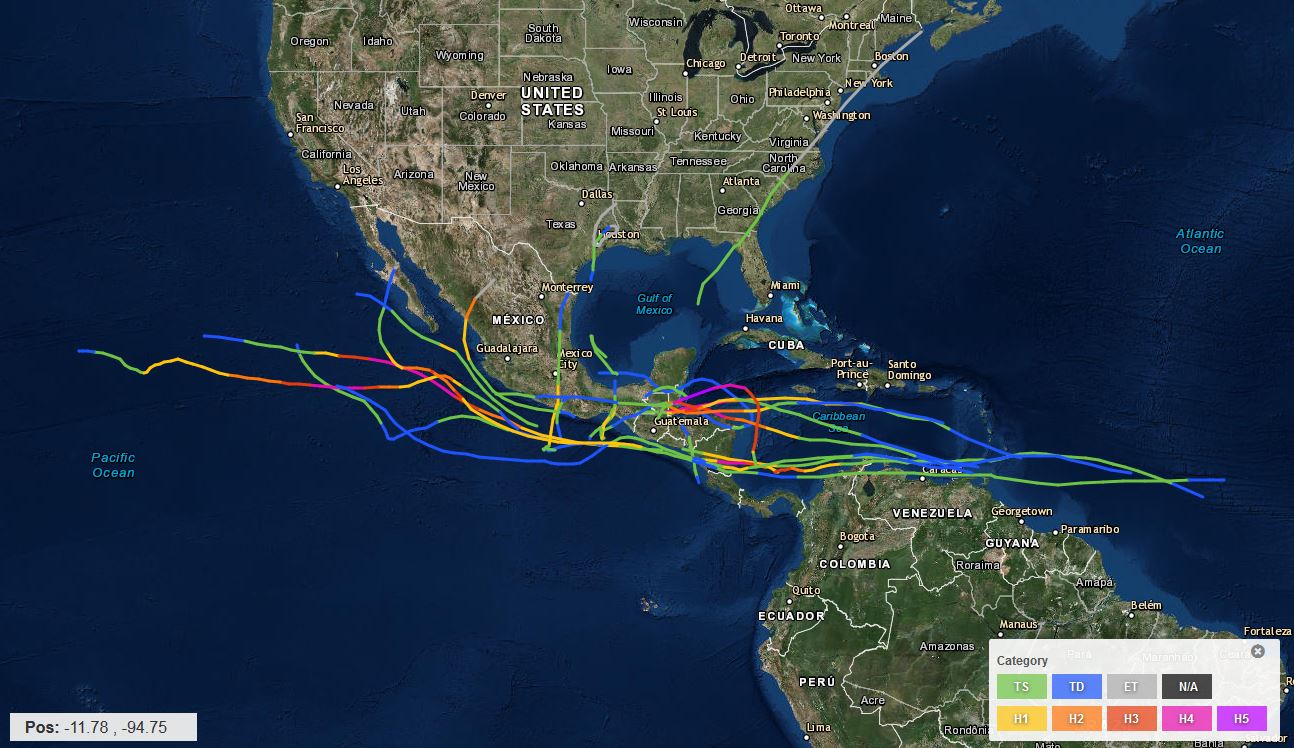
Back to Tropical Cyclones
Records Page | Back
to Main FAQ Page
Subject: E15) What tropical storms and hurricanes have moved
from the Atlantic to the Northeast Pacific or vice versa?
Contributed by Stephen Caparotta, D. Walston, Steven Young, Gary Padgett and Sandy Delgado
Here is a list of tropical cyclones that have crossed from
the Atlantic basin to the Northeast Pacific and vice versa. To
be considered the same tropical cyclone an identifiable center of
circulation must be tracked continuously and the cyclone must
have been of at least tropical storm strength in both basins
(i.e. sustained winds of at least 34 kt, or 18 m/s). This record
only goes back to 1923. Before the advent of geostationary satellite
pictures in the mid-1960s, the number of Northeast Pacific tropical
cyclones was undercounted by a factor of 2 or 3. Thus the lack of
many of these events during the 1960s and earlier is mainly due to
simply missing the Northeast Pacific TCs.
There has not been a recorded case where the same tropical cyclone
crossed from the Atlantic into the Northeast Pacific then crossed back
into the Atlantic, but Hattie/Simone/Inga in 1961 came close. There
is no evidence that a single center of circulation persisted through
several crossings of land, but the envelope of moisture and instability
from one system helped spawn the next.

Tracks of storms that transitioned from one ocean basin to another.
(Courtesy of Ethan Gibney)
- Atlantic Hurricane Otto (November 2016) made landfall in
southern Nicaragua and emerged into the Northeast Pacific as a tropical
storm, dissipating a few days later.
- Atlantic Hurricane Earl (August 2016) made landfall in the
Yucatan Peninsula and dissipated a few days later over central Mexico. The
remnants continued into the Northeast Pacific developing into Tropical Storm Javier,
which made landfall in Baja California.
- Northeast Pacific Tropical Storm Trudy (October 2014) made
landfall on southern Mexico on October 18th and the circulation dissipated over
the rugged terrain of Mexico. The moisture associated with the remnants moved
into the southern Gulf of Mexico where a new circulation developed and intensified
into a tropical depression on the 22nd. The depression weakened into a low pressure
and crossed the Yucatan peninsula reaching the Caribbean Sea where it intensified
into Tropical Storm Hanna on the 27th before making landfall near the
Nicaraguan/Honduran border.
- Northeast Pacific Hurricane Barbara (May 2013) made
landfall on the Tehuantepec peninsula on May 29th and its center of
circulation dissipated before it reached the Gulf of Mexico. However,
its envelope of moisture continued northward and from this Atlantic Tropical
Storm Andrea formed on June 5th in the northeast Gulf.
- Atlantic Hurricane Ernesto (August 2012) made landfall in the
Yucatan Peninsula and dissipated a few days later over central Mexico. The
remnants continued into the Northeast Pacific developing into Tropical Storm Hector.
- Northeast Pacific Tropical Storm Alma (May 2008) became
a remnant low in the Atlantic where it merged with another tropical wave
which generated Atlantic Tropical Storm Arthur.
- Atlantic Tropical Storm Earl (August 2004) dissipated over the eastern Caribbean Sea. Its remnants continued westward and in the Northeast Pacific became Hurricane Frank.
- Atlantic Hurricane Iris (October 2001) become a remnant low
over Central America and regenerated in the Northeast Pacific as Tropical
Storm Manuel.
- Atlantic Tropical Depression Nine (September 2001) made landfall
in Central America and promptly dissipated. Its remnants continued into the Northeast Pacific becoming Hurricane Juliette.
- Atlantic Hurricane Cesar (July 1996) became Northeast Pacific
Hurricane Douglas.
- Atlantic Tropical Storm Bret (August 1993) became Hurricane
Greg in the Northeast Pacific.
- Northeast Pacific Hurricane Cosme (June 1989) became Atlantic Tropical
Storm Allison .
- Atlantic Hurricane Joan (October 1988) became Northeast Pacific
Hurricane Miriam.
- Atlantic Hurricane Greta (September 1978) became Northeast
Pacific Hurricane Olivia.
- Atlantic Hurricane Fifi (September 1974) became Northeast
Pacific Hurricane Orlene.
- Atlantic Tropical Storm Chloe (August 1971) became Northeast
Pacific Hurricane Lily, which made landfall in southwest Mexico.
- Atlantic Hurricane Irene (September 1971) became Northeast
Pacific Hurricane Olivia.
- Atlantic Tropical Storm Laura (November 1971) became Northeast
Pacific Tropical Storm Sharon.
- Atlantic Hurricane Francelia (September 1969) made landfall in
Belize, dissipating over Guatemala and eastern Mexico. The remnants
redeveloped into Tropical Storm Glenda over the Northest Pacific on
September 8th, moving parallel to the Mexican coast until dissipating on the
12th.
- Atlantic Hurricane Hattie (October-November 1961) after
dissipating over Guatemala contributed to the formation of Northeast Pacific
Tropical Storm Simone which crossed the Isthmus of Tehuantepec and merged with
other disturbed weather which later formed Atlantic Tropical Storm Inga.
- Atlantic Hurricane Janet (September 1955) made landfall in Mexico between Vera Cruz and Tampico, dissipating soon after. The remnants continued into the Northeast Pacific developing into an unnamed tropical storm.
- A Northeast Pacific Tropical Storm (September-October 1949)
became an Atlantic Hurricane (Storm #10) and made landfall in TX.
- A Northeast Pacific Tropical Storm (October 1923)
became an Atlantic Hurricane (Storm #6) and made landfall in LA.
Last Revised February 10, 2017
Back to Tropical Cyclones Records
Page |
Back to Main FAQ Page
|
